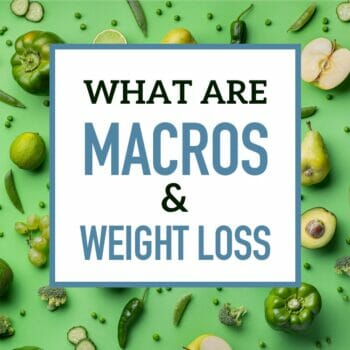TDEE and Macro Calculations for Pregnant or Breastfeeding Women
If you are pregnant or breastfeeding, then counting macros is an effective way to maintain appropriate weight gain.
It’s even more helpful when attempting to lose weight post-pregnancy – healthily and sustainably.
However, you must pay special attention before jumping in.
What should my macros be when pregnant?
Weight gain is a normal part of pregnancy, and increased calories are a necessity.
However, the “eating for two” mindset can sometimes lead to unhealthy and unnecessary weight gain during pregnancy.
Excessive weight gain can lead to complications such as gestational diabetes, high blood pressure, back pain, and obesity after pregnancy.1
When pregnant, you are eating to support a developing fetus.
What is appropriate weight gain during pregnancy?
According to the latest medical guidelines:

Should I measure calories while pregnant?
Pregnant women only need to eat an additional 200-300 calories per day.1
More if you are underweight and less if you are already overweight.
So here’s how that works when calculating your macros.
Example macro calculation for a pregnant woman
A 29-year-old woman weighs 150 pounds, is 5’4″ tall, and does light activity.
Using my calculator, we see that her maintenance calories and macros are:
Total Daily Energy Expenditure (TDEE): 1914 calories.
The calculator recommends the following macro split:
- Carbs: 211 grams (44%)
- Protein: 124 grams (26%)
- Fat: 64 grams (30%)
To account for her pregnancy, she would add calories:
- 1st Trimester: 1914 calories (no extra calories required)
- 2nd Trimester: 2214 calories (300 extra calories)
- 3rd Trimester: 2314 calories (400 extra)
To calculate the macros for the 2nd and 3rd trimesters, some math is required.
2nd Trimester additional 300 calories, split into macros.
- Carbs: 44% of 300 = (.44 x 300) / 4 = +33 grams
- Protein: 26% of 300 = (.26 x 300) /4 = +19.5 grams
- Fat: 30% of 300 = (.25 x 300) / 9 = +10 grams
Final adjusted macros for 2nd trimester:
- Carbs: 244 grams
- Protein: 143.5 grams
- Fat: 74 grams
Not sure of the best path to achieving your health and fitness goals?
How much protein is too much during pregnancy?
Different countries have different recommendations for protein intake during pregnancy.
The broad guidance is 10-35% of energy, with some countries suggesting 15–25% of energy.
The example above shows around 25.9% – however, our macro calculator has an option for more moderate protein amounts (which may be the best option)
How many carbs do I need while pregnant?
A low carbohydrate diet is not recommended during pregnancy – unless you are at risk of gestational diabetes.
The suggestions made by the calculator example above are appropriate.
If you fall into the obese category, you may want to lose fat while pregnant. This may help avoid the complications often associated with obesity and pregnancy.
I strongly advise you to check all of this over with your OBGYN before beginning.
They will understand your complete health profile and can give you the “all clear” before beginning this or any dietary regimen. They will monitor the weight gain of your baby and make sure you are on track for a healthy pregnancy.
What should my macros be when breastfeeding?
If you want to lose the weight gained during pregnancy, then counting macros is a great option.
It allows you to maintain a safe calorie deficit for fat loss while having the resources to produce a nutritious milk supply for the growing baby.
Step 1: Get your base calorie needs.
Experts recommend that breastfeeding mothers consume 400-500 extra calories during the breastfeeding period.2
Some sources say as little as 300 extra, but if a woman is also trying to lose weight, 300 might not be enough to produce highly nutritious milk.
Here’s an example using the macro calculator.
Let’s say a 29-year-old woman is 150 pounds and 5’4″ tall and does light activity. Set the calculator to a goal of lose weight. TDEE and macros are as follows:
Total Daily Energy Expenditure (TDEE) for weight loss: 1531 calories
- Carbs: 144 grams (37.7%)
- Protein: 124 grams (32.3%)
- Fat: 51 grams (30%)
Step 2: Adjust calories for breastfeeding
Add an additional 400 calories to the TDEE.
Breastfeeding Adjusted Weight Loss TDEE: 1931 calories
Step 3: Adjust macros for breastfeeding
To adjust the macros, we ration them out at the percentages given:
The Math:
- Carbs: 37.7% of 400 = (.377 x 400) / 4 = +37.7 grams
- Protein: 32.3% of 400 = (.323 x 400) /4 = +32.4 grams
- Fat: 30% of 400 = (.30 x 400) / 9 = +13 grams
Breastfeeding adjusted weight loss macros:
- Carbs: 181.7 grams
- Protein: 156.4 grams
- Fat: 64 grams
Some women with a lot of weight to lose may be OK with just adding 300 calories, while others may have to add in 500.
Always consult with your OBGYN or Pediatrician before beginning any diet while breastfeeding.
What food should I eat?
While macro tracking may give you the freedom to satisfy your ice cream cravings, I can’t stress enough the importance of following the 85:15 healthy eating guideline.
During pregnancy and breastfeeding, 85% of your diet should be nutritious, whole foods.
15% can be the treats, snacks, and processed foods you may be craving.
Aim for:
- Lean proteins
- Healthy fats
- Fresh vegetables
- Fresh fruit
- Whole grains
See a comprehensive list of the best foods to choose for each macro.
Need some help?
If you need help, I can calculate everything for you as part of my comprehensive macros coaching package.
View article sources“Being a sleep deprived new mom with a 4 month old and working a full time job with back-to-back meetings, I did not think losing weight would be possible for me. Ted was very flexible and put together a plan for me that worked. My main concern was to not lose my milk production for my baby but also wanted to make sure I lost weight.
Not only did his nutrition plan work, but I lost 15 lbs total without being able to workout as much with my busy schedule!
I highly recommend working with Ted!” -Esther
Sources
- http://health.utah.gov/mihp/pregnancy/preged/duringpreg/Too_much_weight.htm
- http://www.mayoclinic.org/healthy-lifestyle/infant-and-toddler-health/in-depth/breastfeeding-nutrition/art-20046912
- http://www.llli.org/nb/nbmarapr04p44.html
- Rasmussen, K. M., Catalano, P. M., & Yaktine, A. L. (2009). New guidelines for weight gain during pregnancy: what obstetrician/gynecologists should know. Current opinion in obstetrics & gynecology, 21(6), 521. link
- Blumfield, M. L., & Collins, C. E. (2014). High-protein diets during pregnancy: healthful or harmful for offspring?. The American journal of clinical nutrition, 100(4), 993-995.
129 Comments


 How to track macros with Cronometer
How to track macros with Cronometer What Are The Best Macros For Weight Loss?
What Are The Best Macros For Weight Loss? How To Count Macros on a Vegan, Vegetarian, or Plant-Based Diet
How To Count Macros on a Vegan, Vegetarian, or Plant-Based Diet Out of a Macro For the Day? Here’s What to Eat
Out of a Macro For the Day? Here’s What to Eat Macros for Gaining Muscle and Cutting Fat
Macros for Gaining Muscle and Cutting Fat
This is so helpful thank you!
Hi Hollie, So glad it was helpful. All the best with your goals! -Coach Ted
Hi!
I visited your site after the birth of my daughter 9 months ago to figure out my macros while breastfeeding. I’ve had great success focusing on macros in the past, but with the new challenge of bf I needed a little help. Since then I’ve lost the 65 (!!) pounds that I gained during pregnancy. I’m at the point where I have about 10-15 more lbs that I can lose/change so my question is this: knowing that I’ve already lost a lot of weight and my progress has of course slowed and that I’m still breastfeeding but beginning to wean — should I stay consistent with my 1800ish caloric intake or start to shift? Do I need the same calorie intake during weaning? Thank you!
Hi Lauren, That’s amazing! Great job with tracking macros and consistency. I’d start cutting back since you’re weaning. Perhaps start with 150 fewer calories daily and go from there.
Thank you!!
Hi! I’m in my second trimester of pregnancy and I loved your article about how to calculate your new macros for pregnancy, but when calculating the “base” macros do you use the pre pregnancy weight? Or should I use my weight now in my second trimester and then add the additional macros needed? Thanks!
Hi Taylor, So glad you found the information useful. You’d use your prepregnancy weight. All the best for a healthy pregnancy!
Hi there, sorry but I’m very confused. Prior to my pregnancy I was doing no-so-strict Keto and I had an additional 30 lbs to lose. Am I basing my pregnancy macros off of my maintenance numbers or weight loss? The calculator says that since I’m 33 y/o, 5’6 and 175 lbs my weight loss calories should be 1684. So I should stick to 1684 cals during the first trimester? Or am I using maintenance figures?
Hi Christine, Congrats on your pregnancy! You should eat at maintenance during the first trimester to be on the safe side but some overweight women can be in a slight deficit and benefit. I think you should consult with your OBGYN if you want to do the latter. They’ll be able to determine if this strategy is right for you.
i think u could stop Keto program
I was 80kg pre pregnancy (BMI 28 overweight). 21 weeks pregnant I am now 87kg (so I definately gained too much too quickly!). I was told to try keep my weight similar to how it is now for the next few months! I believe this means I do TDEE based on pre pregnancy weight, then add on 200 cals maybe? thanks
Hi Laurel, I’d double-check this with your OBGYN but you probably don’t have to add any extra until your 3rd trimester since you’re overweight. If you need help with those calculations, reach out via my coaching page: Personalized Macros Coaching
i need some help with this, please
Hi Nijaye, I’m happy to help you and do all the calculations for you. Please see the options on my coaching page and there’s one for just calculations. Personalized Macros Coaching
Thanks for the article, I find it quite helpful. Does this type of tracking account for fiber and net carbs?
Hi Michelle, Counting macros does involve tracking fiber, but I advise people to track total carbs. The net carb information for foods isn’t always available or accurate.
For the breastfeeding adjust TDEE, why is the fat calculation divided by 9, instead of 4 (like carb/protein)
Thanks!
Hi McKenna, Sure, for both carbs and protein there are 4 calories per gram but for fat, there are 9 calories in each gram.